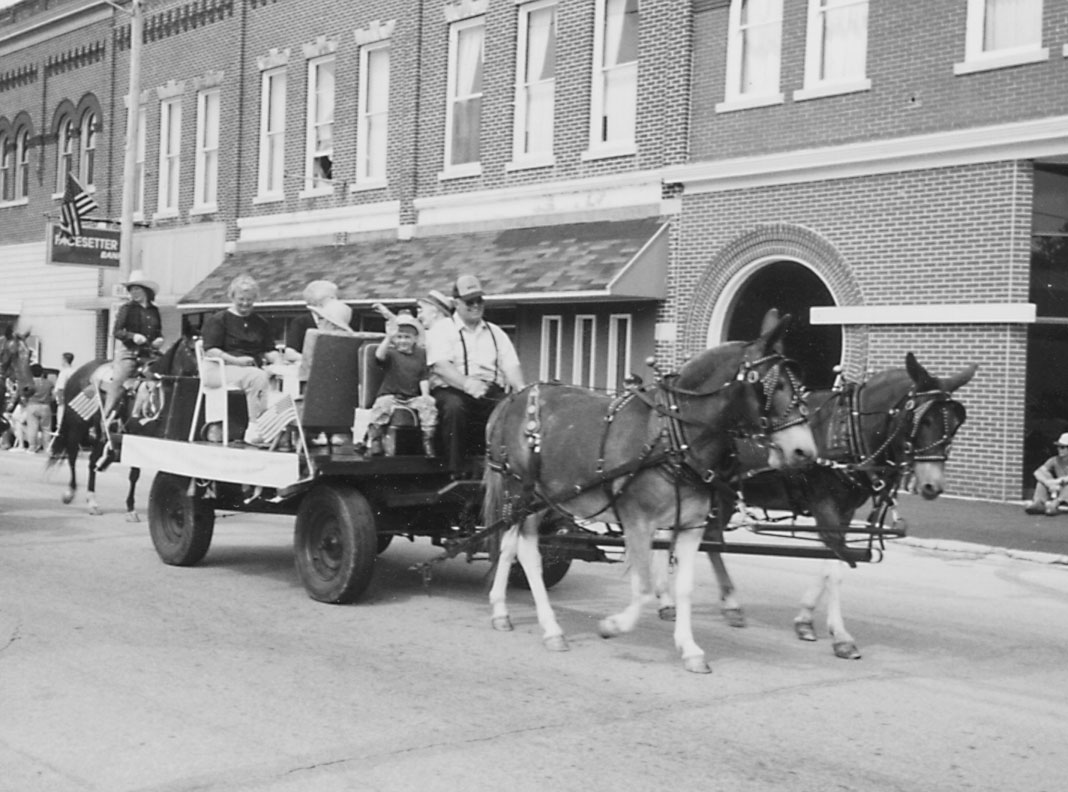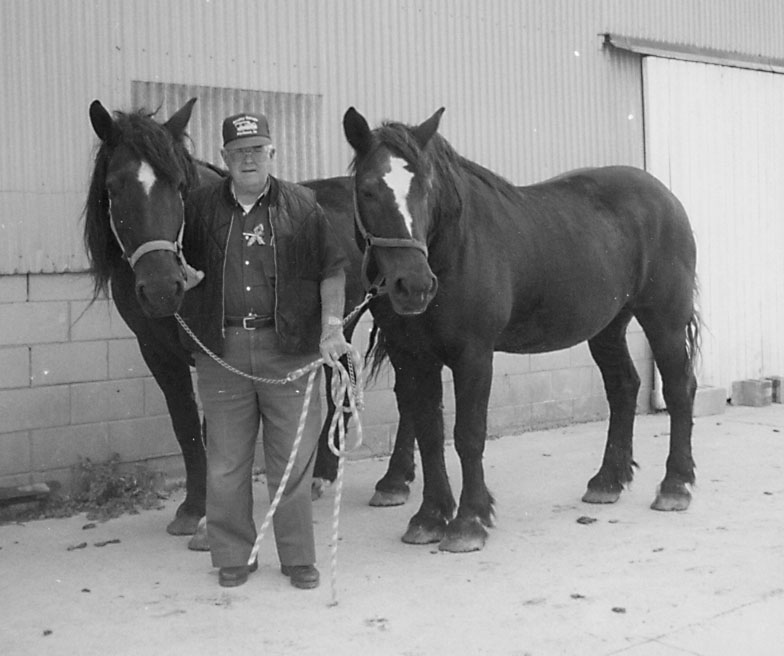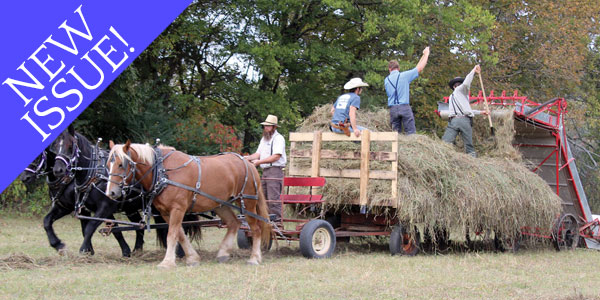
Mule Truths

Mule Truths
Dear Mr. Lynn R. Miller,
I have been a subscriber of SFJ for several years as well as sending it to a friend as a gift subscription. My wife and I, we are both 81 and will have our 61st wedding anniversary this October 25th, enjoy SFJ very much. Enclosed are a couple pictures. One is at the Pennville, Indiana fair parade in 1992 of our mules and other taken last fall in our back barn lot of our registered Percheron mares that are full sisters. The mares weigh 3300 lbs., Dolly, with most white in her face, 1660 lbs. and Diana behind me 1640 lbs. The span of mules weigh 1000 lbs. each.
We paraded the mules a lot and braggin’ a bit won 1st place 75 percent of the time. We paraded the horses some but two heart attacks March 27, 2001 put an end to my parades. I still am able to feed and enjoy the horses but am unable to put the heavy harness on them.
My good friend, Karl Fennig, who also has horses, work and riding, and a big mule, comes over and helps harness the Percherons to hitch to spreader to clean out stable. Another farmer friend, Herb Statton brings his Bobcat skid loader to load the horse manure. We all three are retired and have our aches and pains so we have had to learn how to cut the corners on hard labor. Herb has grade beef cattle.

The main object, or is supposed to be, of this letter, is to reply to the article on page 66 of Winter 2002 issue of SFJ on “The Reluctant Mule.” I agree with your statement “we do not agree with this article.” I would go a bit farther than Justin E. Miller’s statement. If the man said that about my span of mules I would put him in the middle of a 3-abreast hitch hooked to a plow and lay on the whip to the one in the middle.
You don’t have to cuss a mule. Your cussing only shows your ignorance and inability to get him to do the task. You should be almost as smart as the mule. To know them is to love them. Remember honey catches more flies than vinegar.
The tractor didn’t put the mule out of business. It changed some of the work done by mules. A couple of years ago when IHC Farmall tractors were the featured tractor and they had all the old ones painted gray up to the latest models, a man in our party made the statement pointing to the old gray Farmall’s, “now there’s what paid for our farm,” then pointing to the latest red one, “there’s what’s losing them, too much money and interest on debt.”
Most of the farms if not all of them waste enough feed to feed a span (2) of mules every year. The mules can do a lot of jobs cheaper than a $100,000.00 tractor. To these young modern day big time farmer’s they don’t want a mule. You can’t turn the key off on a mule like a tractor and go fishing up in Canada for a couple weeks all the time complaining, “there isn’t any money in farming.”
A mule won’t kick you any quicker than your dog will bite you. When you mistreat your dog he bites you in self-defense and when you mistreat a mule your payback is a kick which you deserve.
There were a lot of ill-tempered mules because most of the horse mares bred to a donkey jack were the misfit, bottom of the barrel mares. The good mares were bred to a horse stud.
You teach a mule what to do and it never forgets it and resents you going over the same routine time after time. A mule also is careful where he puts his feet. He is smart enough to know unsound ground is not safe walking. A dumb man will try to walk across a bridge when half of the planks are either missing or broke. A mule is the smarter of the two.
Mules were also used to transport equipment and supplies in the mountains of Italy against the Germans in World War II.
The writer states at present, the big mule states are all below the Mason- Dixon Line. For the writer’s information, it has always been that way. Why, because nothing else except maybe a camel could have endured the hot, dry, ill-fitting harness, lack of good pasture and grain that the mule had to.
I resent his statement concerning the four sorrel mules used in President Truman’s inauguration. He states they behaved in a very un-mule like manner, almost like gentlemen.
I never had any trouble with the mules I paraded except once at a parade in Portland, Illinois. A very un-gentleman like Indiana State Police Trooper was just behind me in the parade. I don’t know if he thought people wouldn’t know who he was by the markings on the state patrol car or what. He tried to wear out his siren by continuously blasting it. The mules couldn’t hear my commands, therefore they didn’t know for sure what to do. When the Trooper would turn on the Wolf-Wolf part, that really upset them. Don’t blame the mule.
Now it’s not the bad behavior of the mules, it’s the behavior of the dumb jerk of a human who is the cause of your problems.
In the picture on page 68 of SFJ of the mules cultivating cotton, just look at the ill-fitting harness. Any good horseman wouldn’t be caught in a dark alley working a mule with harness like that. The back-strap is too short which in turn holds the chain tugs up too high. The tug should be in straight line from the shoulder-point to singletree. No wonder the mule had sore backs and shoulders which caused him to work slow or balk or maybe both. Ever walk with a rock in your shoe?
My father-in-law who was a great and good horseman used to have some good Belgian horses. He had some bad luck and started using mules which he continued for years never going back to horses.
He got me started using mules, a thing I have never regretted.
Back in the 1940’s my first span of mules were a span of black mare mules that weighed 2550 lbs. with the harness on. They were fast walkers, broke to a T, and you could back a corn planter in a shed as long as the shed door was three or four inches wider than the planter, by voice command, never touching the lines. You could load a load of wheat or oat bundles when threshing by voice command. Labor was unavailable during World War II and when making hay I would set the hay fork and do the mowing, back in hay loft and my wife would lead Topsie mule back and forth on hay rope that pulled the hay up into the loft area. You could tend the garden and a mule would never step on a plant.
These people who think the only way you can get a mule to work or ride or anything else is to beat and mistreat the mule just doesn’t understand the mule. In short they are not as smart as the mule and get flustered and take their anger out on the mule.
I am enclosing some mule magazines that may shed some new ideas on mules to you.
To update you on my mules, I had to have a Vet put Sally, the near mule, down last September. Sarah, the offside mule simply grieved herself to death after Sally was gone. Sarah must have gone from barn to the pasture field a thousand times looking and braying for her mate. They had been together over 25 years. She would go off feed and wouldn’t eat for days at a time. We doctored her with a Vet but nothing helped her. This April when I went to feed one morning she lay dead in her stall.
I would like another span of mules but at my age and since my heart attacks, my health is such that all I can do is dream about another span of mules and remember the ones I’ve had in the past. The sun is setting in the west but it hasn’t set yet for me.
Hope this letter and mule books are of some use to you.
Sincerely,
Fred Conkling
Redkey, Indiana
Post Script
I don’t remember if I related the story on the walnut logs…
Karl was a log buyer for Frank Miller Lumber Co. of Union City, Indiana. Karl covered an area that extended out from Union City for a radius of 200 miles into the states of Indiana, Ohio, Michigan, Kentucky, and Tennessee. He had several men who worked their local home area spotting timber for him. Frank Miller was and still is a big producer of lumber from logs to boards. They export as well as supply U.S. trade.
The woods south of Winchester, Indiana, which is about 15 miles south of Karl’s home and 25 miles southeast of me, had 34 matured walnut trees in it. All big enough that you could get two to three good logs from each tree.
The old man who owned the farm and woods would not sell the walnut trees unless the buyer would skid the logs out of the woods with horses. No power skidders or bulldozers tearing up his woods.
Karl promised the gentleman that he would bring his own team of horses and my mules to skid the logs out of the woods into an open field next to roadway and no power equipment other than chainsaws would be in the woods. Karl got the trees hence the picture of the mules hauling logs from woods area to loading site for transport trucks.
We skidded the logs to a clearing at edge of woods, and then loaded them on wagon for the ½ to ¾ mile trip to truck loading area. It was faster than dragging a log at a time, that distance.




